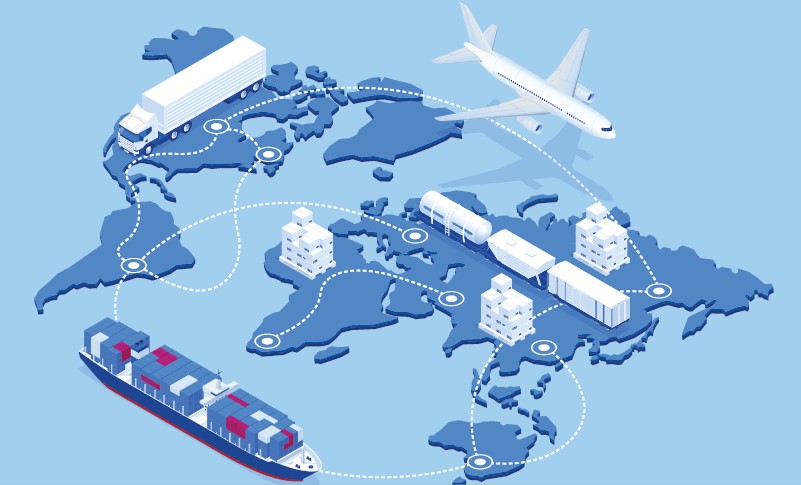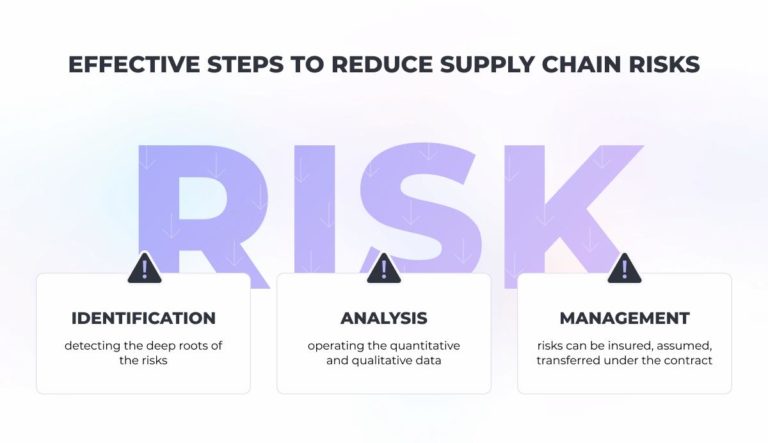According to a Deloitte report, more than 85% of the global market leaders have suffered the disruption of retail supply chain operations, having no proper software support. The more sophisticated the supply chain is, the more risks the business has to take into account since its reputation and loyalty are at stake.
A timely risk detection, analysis, and mitigation are now possible with the support of powerful technology solutions. They allow you to gain insight into value-gaining risks and save the retail business value by reducing losses and gaining absolute transparency.
The current situation demands upgrading of retail business risk management techniques, supported with in-depth planning and sufficient software. In this article, we are going to discuss the main supply chain risks, analyze the most efficient retail risk management strategy supported by the latest software solutions, allowing to decrease the risk impact to the minimum.
What is retail risk management? What are the best risk mitigation practices?
Retail businesses are exposed to various risks all the time. These risks affect day-to-day operations, lowering revenue and increasing expenses. The impact can be rather destructive, leading to tremendous losses and even failures. Since the landscape for enterprise risk management is complex and vast due to a variety of stages and processes in the supply chain, the leverage of technology and analytics is a crucial benefit. It has gained tremendous popularity among business owners enabling in-time risk detection and efficient mitigation.
We have conducted a survey among our clients from the retail industry concerning the most widespread risks and challenges they face in the supply chain. Based on their answers, we have concluded that every company, regardless of industry, is exposed to internal and external risks from the supply chain disruption.
Major threats influence product manufacturing and delivery flows. The number one reason is the lack of adequate prediction and retail risk management strategies. It is rather challenging in the modern market conditions due to globalization, raw materials for goods manufacturing and faulty defense systems, etc. Due to its volumes, it becomes rather impossible to predict and identify the available retail risk issues in the supply chain industry.
However, the best strategy is to address the issues structurally. First, approach the available risks. Then, take measures to enhance the company’s resilience to the unknown risks, like natural disasters or medical issues, since they potentially may transform into serious problems affecting the supply chain. Here is the list of possible risks in the supply chain:
- Global risks. Economic crises, limited access to raw materials, political instability, new legal requirements, natural disasters
- Operational risks. Planning stage risks, buying risks, manufacturing risks, new product launch risks.
- Business risks involving customers and suppliers. Risks of suppliers and their contractors, risks of companies providing outsourcing services, risks of consumers.
- Functional risks. Risks of incorrect legal and tax support. Risks of personnel selection, risks of IT support.
- Planning and control risks. Inaccurate forecasting and assessment.
- Natural disasters and predicted political and medical issues. For this particular group of risks, reducing their probability and opportunity to provide rapid response in case they occur is of the utmost importance to sustaining competitive advantage.
Demand forecasting software and supply chain risk mitigation
Supply chain management is all about managing the flow of goods. Specifically, it includes producing final products out of raw materials and shipping it to customers. It includes planning and management of all the key processes, including:
- Sourcing
- Procurement
- Shipping
- Transportation costs
- Conversion
- Management functions
Strategic planning is impossible without the demand for forecasting. Demand forecasting stands for the estimation of the expected customer requirements, based on historical sales data. Aggregated forecasts help decrease the violations in this field and make it more accurate. As a branch of strategic business planning, it sets in motion such processes as raw material planning, purchasing, and also involves logistics issues.
The importance of demand forecasting in retail risk management is immense since it sets the goals and funding for the newly launched products and already available ones, allowing to increase the revenue rates and meet sales goals, aiming to retain the market share.
Benefits of demand forecasting retail risk management software:
– Increase of customer satisfaction – the end-customer receives the desired product in time
– Better evaluation of capacity and resources allocation – accurate estimation allows to make the precise raw material distribution, thus relevant resource allocation and optimization of the product delivery schedule.
– Providing the exact inventory throughout the supply chain – minimizes the bullwhip effect and reduces overstocking
– Optimization of supplier and purchase terms – accurate raw resources’ distribution, purchasing, production processes, and inbound logistics are accurately planned which enables earlier sharing with the suppliers and decides on the better terms.
Demand management solutions have brought demand forecasting to an absolutely new level, allowing absolute security, accuracy, higher efficiency, thus effective retail risk management through more accurate planning.
Powering risk management in retail practice with AI
Following the latest updates in the tech world, AI (Artificial Intelligence) technology occupies the leading position covering all industries, due to the unique tech opportunities and perspective it offers. Risk management in retail practice is not an exception. Generally, it allows important decisions supported by the successful application of cognitive predictions and recommendations, resulting in the most effective solution in every situation. While used widely in practice, it proved to be successful in enhancing the overall supply chain performance. Rapid decision-making and cycle-time reduction and main supply operations optimization – these are the critical points when it comes to maximizing productivity and reducing uncertainties. Powered by AI, supply chain and logistics management has reached an absolutely new level.
AI and Machine Learning (ML) are rapidly transforming the supply chain industry, allowing accurate capacity planning, cost-reduction, better productivity and, most importantly, prediction of safer working conditions and successful risk management in retail.
According to the Forbes report, “49% of Supply Chain Leaders (the top 12 % of respondents) can capture real-time data insights and act on them immediately, while 51% use AI and predictive analytics to capture insights.”
AI benefits for the supply chain industry:
Retail Risk management software is powered by AI and addresses the main business goals, from procurement to sales. AI assists in processing enormous volumes of data, enhances operational visibility, and allows for precise decision-making.
Here is the list of the main advantages that AI provides for retail risk management:
- Successful inventory management
- Reduction of the potential errors and preventing overstocking. Since AI can process huge amounts of data within the blink of one’s eye, it allows learning and predicting consumer behavior, potential seasonal demands, effective time management as well as supply and demand forecasting.
- AI-driven automation increases the warehouse efficiency
- Security enhancement, smarter planning, and better warehouse management through rapid data analysis and preliminary risk warning.
- Cost-reduction through the successful automation of the warehouse processes and elimination of operational bottlenecks along the value chain
- Bolstering the schedule – accurate planning for profitable supply network accounting.
- Intelligent decision-making
- AI allows the extraction of valuable analytical insights for successful inventory and demand management. The automated critical analysis allows effective planning and in-time retail risk management.
Altamira implements AI technology which allows successful handling of data, associated with managing the flow of goods and services, and legacy platforms to satisfy the demand of modern supply chain industries. Since AI technology allows immediate pattern recognition, supply chain industries can successfully identify the areas for improvement, predict the demand, and plan inventory. As a result, you get an optimal schedule of maintenance and in-time prediction of potential equipment failures.
What can warehouses do to minimize supply chain risks?
Shipping and data in the modern world are essential for building successful logistic operations. However, these areas do not allow to resolve all the supply chain issues for efficient retail risk management. The lack of proper visibility of the warehouse data limits the possibilities of the introduction of immediate changes, responding to snarls and backlogs. As the practice shows, the real-time visibility issues start in a warehouse.
For example, live access to big data can define which trucks or ships have stopped and for how long. Insights like this one allow to prioritize and assign the workload reasonably, thus improving customer fulfillment, decreasing the risks, and avoiding unpredicted fees.
The warehouse is the heart of the supply chain, and the subject of efficient digital transformation to mitigate risks successfully. The efficient strategy for tech transformation includes:
- A series of industry-standard KPIs
- Real-time operational visibility
- Productivity metrics
- Inventory visibility
- Labor management
Depending on the warehouse, the KPI may vary, however, here are the most widely applicable:
- Days to sell inventory. The algorithm allows calculating the time needed to convert inventory into sales
- Out-of-stocks. Reduces error-prone manual work automation and allows better inventory monitoring
- Return rates. Efficient estimation of the return rates, combined with the in-depth analysis for cost-saving and ability to avoid future returns
- Real-time visibility is a must-have since it allows excluding the possibility of warehouse issues such as unforeseen blockages to increase overall distribution efficiencies.
Why Quality Assurance is important in the supply chain?
Quality assurance in the supply chain is the vital issue that allows making thoughtful and pre-planned decisions by stirring the wheel in the right direction. It influences the quality of product delivery and the level of customer satisfaction. The aspect of quality assurance is vital for the retail industry since it involves the set of the right efforts, allowing to avoid the possible defects.
Altamira successfully implements various forms of QA testing, including:
Altamira specializes in the supply chain niche, providing secure and exact testing to eliminate even minor defects to secure the smooth functioning of all the retail risk management software components.
Effective steps to reduce supply chain risks
Reduce the risk exposure through the utilization of efficient strategies. Here is the basic algorithm for detecting the possible risks:
Risk identification
Detect the deep root causes of risks. This stage allows us to get the qualitative and quantitative evaluation of the risk and assess the possibility of it. The results will help you to elaborate on an effective retail risk management strategy less hazardous and more effective.
Risk analysis
This stage is based on the data received from the identification stage. Risk analysis is always based on a particular model, operating the quantitative and qualitative data extracted during the risk identification stage.
Risk management
The obtained existing or potential risks can be insured, assumed, transferred under the contract, avoided, or it is possible to take measures to reduce the inevitable losses, etc.
However, the methods used to identify, analyze, and manage risks vary greatly depending on the type of risks as well as their allocation in the supply chain.
Here are the main points to consider while implementing supply chain management risk in retail:
- Specification that includes risk description.
- Description of risks using numerical data.
- Risk analysis and the creation of a corresponding efficient management strategy.
- The identification of the required resources for efficient risk mitigation.
- Data visualization is a must in efficient risk management practice.
Effective supply chain risk mitigation should be based on a number of organizational and economic measures allowing to minimize or eliminate the possible risks. The list of measures includes:
1) The availability of reliable real-time data;
2) Taking control over the supply chain includes implementing preventative measures, aimed to define critical points of the supply chain that reduce the likelihood of risks and minimize the negative impact;
3) The deep knowledge and experience of using the regulatory materials and software products (SCEM, SCM) for the immediate response to the identified risks;
4) The availability of a developed production and logistics infrastructure, reservation of logistics capacities;
5) Insured goods, the liability of the carrier, forwarder, warehouse operator in the processes of transportation, warehousing, cargo handling;
6) A timely adoption of the necessary measures to prevent further damage from the supply chain risks.
Minimize the losses with the retail risk management software
Supply chain management roles assist in detecting and taking control over the identified and potential supply chain risks. Here are the main features of the risk management tools:
- Order intake tools;
- Shipping control and coordination tools;
- Order supply tools;
With the global digitalization of the retail industry, more and more steps of the supply chain become automated. The strong necessity for using retail risk management software that enables considerable speed benefits and provides the advantage of using precise data. It allows gaining a considerable competitive edge in the overcrowded market arena.
Modern retail risk management software offers a variety of features that enable:
Altamira – advanced provider of supply chain risk mitigation solutions
Altamira has more than 10 years of software development expertise in different domains. We are geared towards efficiency so we thoroughly analyze every project, its statistics, and make sure to learn out lessons. Such practice helped us to prepare work arounds to address the most common risks of the supply chain industry.

Our team of experts will upgrade and enhanceмyour retail risk management software with the desired set of features, providing unique benefits for your industry. We offer ERP-enhanced solutions and CRM business management systems, allowing you to automate most business processes. Moreover, technologies facilitate the supply chain control, efficient risk management planning, and overall planning within the company.
You can get either the custom-built solutions from scratch or enhance the available tech tools with AI-powered features. Altamira developers can collect all the available data from your company’s software, making exact analytical predictions. We also offer an opportunity for code refactoring that can help you deal with over-complicated, poorly-written code and keep it bug-free for new features.
To sum up
The worldwide rollout of technology solutions has left its fingerprint on the supply chain industry as well. Implementation of technology has turned out to be especially efficient when it goes about successful retail risk management. Supply chain disruptions make the industry vulnerable to risks and demand taking rapid decisions to eliminate the possible inefficiencies with the speed of light. With the support of powerful tech solutions and the latest technologies, it is possible to efficiently prevent the possible risks and immediately mitigate the available ones.






